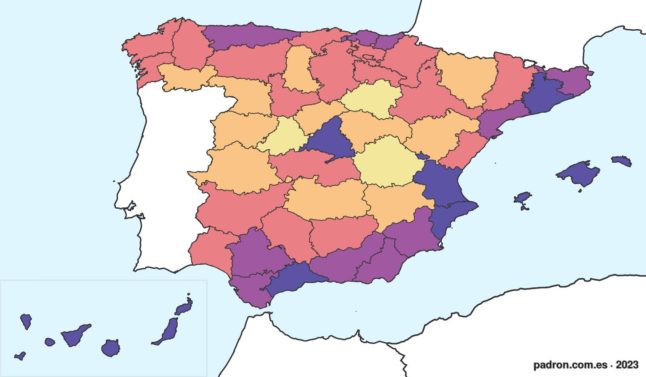Spain’s Irish community number 19,491 according to the latest figures from Spain’s National Statistics Institute (INE), which makes them the third largest English-speaking group in Spain behind Brits (more than 400,000) and Americans (41,950).
The number of Irish nationals who reside in Spain has increased by 2,822 compared to 2022’s stats, continuing with the upward trend seen over the past five years.
READ ALSO: Spain holiday homes – Which nationalities favour which coastal regions in Spain?
There’s an even distribution of Irish men and women in Spain, with the majority aged between 40 and 60.
Where do most of them live?
Spain’s Irish community favours coastal locations generally but also the country’s two biggest cities – Madrid and Barcelona.
Of Spain’s 50 provinces, Málaga is home to the biggest Irish community with 3,494 Irish nationals. Next is Alicante province in the eastern Valencia region, where 2,916 reside.
Barcelona, with 2,472 Irish nationals, and Madrid with 2,021, are the third and fourth provinces with the biggest Irish representation in Spain.

They also like Spain’s islands. A total of 885 live in the Balearic Islands where Mallorca, Menorca and Ibiza are.
Las Palmas de Gran Canaria province (which includes the islands of Gran Canaria, Fuerteventura and Lanzarote) is home to 1,658 Irish nationals and the next-door province of Santa Cruz de Tenerife (Tenerife, La Gomera, La Palma and El Hierro) is where 807 live.
READ ALSO: Why are there so many Irish street names in Spain’s Canary Islands?
Other worthy mentions are Murcia (550), Almería (522), Cádiz (350) and Granada (307), all coastal provinces in Spain’s sizzling south, Valencia province (845) next to Alicante and Girona (266) and Tarragona (243) in Catalonia.
If you’re wondering what brings Irish people to Spain, the following interview-based article covers exactly this, as well as advice for other Irish nationals considering Spain as a possible home away from home.
READ MORE: The charms and challenges of life in Spain for its Irish residents
What associations can Irish people in Spain join?
According to the Irish embassy in Spain website, there are a number of groups and organisations Irish people can join if they want to meet their fellow countrymen and women.
These include the Irish Club in Marbella, CARA, the official Irish/Basque Association, Irish in Barcelona, Valencia Irish Cultural Association, Asociación Española de Estudios Irlandeses and Irish Community in the Balearics.
There are also a number of Gaelic Athletic Association (GAA) clubs dotted around mainland Spain: Madrid Harps, Costa Gaels GAA, Eire Og Sevilla GAA, Galician Gaelic Games Association, Sant Vincent GAA Valencia, Barcelona Gaels GAA Club, Celta Malaga GAA, Gaélicos do Gran Sol GAA and Zaragoza GAA, Gaelic Games Andalucia GAA.
What about Irish tourists in Spain?
According to Spain’s Tourism Ministry, Spain continues to be the number one holiday destination for Irish residents, closely ahead of France, Italy and Portugal.
A total of 2.08 million Irish tourists visited Spain in 2022 (including repeat visits), spending on average €1,240 on their vacations. The Canary Islands (30 percent) and Andalusia (22 percent) were their favourite holiday locations.
READ ALSO: Swapping Dublin for Madrid – The right escape from Ireland’s cost-of-living crisis?



 Please whitelist us to continue reading.
Please whitelist us to continue reading.
Member comments